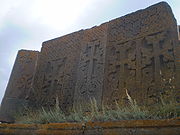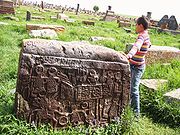
Noraduz cemetery
Encyclopedia
Noratus cemetery or Noraduz cemetery is a medieval cemetery with a large number of early khachkar
s located in the village of Noratus
, Gegharkunik marz
near Gavar
and Lake Sevan
, 90 km north of Yerevan
. The cemetery has the largest cluster of khachkars in the republic of Armenia. It is currently the largest surviving cemetery with khachkars following the destruction of the khachkars
in Old Julfa, Nakhichevan
by the government of Azerbaijan
.
 The oldest khachkars in the cemetery date back to the late 10th century. During the revival of the khachkar tradition in the 16-17th centuries many khachkars were built under the yoke of the Safavid Empire when oriental influences seeped into Armenian art. Three master carvers from this period carved khachkars in Noraduz, the most notable of whom was Kiram Kazmogh (1551-1610), his contemporaries were Arakel and Meliset. The cemetery is spread over a seven hectare field containing almost a thousand khachkars each of them depicting unique ornamentation. The majority of the khachkars are covered by moss
The oldest khachkars in the cemetery date back to the late 10th century. During the revival of the khachkar tradition in the 16-17th centuries many khachkars were built under the yoke of the Safavid Empire when oriental influences seeped into Armenian art. Three master carvers from this period carved khachkars in Noraduz, the most notable of whom was Kiram Kazmogh (1551-1610), his contemporaries were Arakel and Meliset. The cemetery is spread over a seven hectare field containing almost a thousand khachkars each of them depicting unique ornamentation. The majority of the khachkars are covered by moss
and lichen
. Several tombstones in the cemetery depict carved scenes of weddings and farm life. Adjacent to the old cemetery a new modern cemetery has been built separated by a long fence. Nearby the cemetery in the village there is the Holy Virgin church built in the ninth century. One of the khachkars from the cemetery was donated to the British Museum
in 1978 by Catholicos
Vazgen I
. The front face of the rectangular khachkar has a leaved-cross with two smaller crosses below that are framed with trefoil
and bunches of grapes projecting from either side. An inscription on the left side seeks god's mercy for a certain Aputayli.
 A popular folktale associated with the cemetery concerns the invading army of Tamerlane. According to one story the villagers placed helmets on top of the khachkars and leaned swords against them. From a distance the khachkars looked like armed soldiers holding a defensive position as a result of which Tamerlane’s army retreated.
A popular folktale associated with the cemetery concerns the invading army of Tamerlane. According to one story the villagers placed helmets on top of the khachkars and leaned swords against them. From a distance the khachkars looked like armed soldiers holding a defensive position as a result of which Tamerlane’s army retreated.
In another popular story, the 19th century monk named Ter Karapet Hovhanesi-Hovakimyan, from a monastery near the village, conducted burial services at Noraduz; in order to avoid the two-hour round trip from the cemetery to the monastery he built himself a small cell in Noraduz. When he was 90 years old, he asked his brother monks to bury him alive. His last words were: "I do not fear death. I would like you to not be afraid also. Never fear anything, but God alone. Let anyone who has fear come to me. Pour water at the burial stone, drink the water, wash your face, chest, arms and legs. Then break the vessel that contained the water. Fear will then abandon you." To this day people come to the monk's grave to perform this ritual, leaving broken pieces of glass scattered all about.
Khachkar
A khachkar or khatchkar is a carved, cross-bearing, memorial stele covered with rosettes and other botanical motifs. Khachkars are characteristic of Medieval Christian Armenian art found in Armenia.-Description:...
s located in the village of Noratus
Noratus
Noratus is a village in the Gegharkunik province of Armenia near the town of Gavar. It contains the famous Noraduz cemetery. The village also contains a monastery and church dated to the 9th century, and a ruined basilica built by Prince Sahak....
, Gegharkunik marz
Marz
Marz may refer to:people* Ron Marz, comic book author* Richard Marz, Canadian politician* Marz , an American rapperother* Marz , the first order administrative division of Armenia...
near Gavar
Gavar
Gavar , is a city and the provincial capital of the Armenian province of Gegharkunik. It was known as Nor Bayezet or Novyi Bayazet until 1959, then Kamo until 1996...
and Lake Sevan
Lake Sevan
Lake Sevan is the largest lake in Armenia and the Caucasus region. It is one of the largest high-altitude lakes in the world.Lake Sevan is situated in the central part of the Republic of Armenia, inside the Gegharkunik Province, at the altitude of 1,900m above sea level...
, 90 km north of Yerevan
Yerevan
Yerevan is the capital and largest city of Armenia and one of the world's oldest continuously-inhabited cities. Situated along the Hrazdan River, Yerevan is the administrative, cultural, and industrial center of the country...
. The cemetery has the largest cluster of khachkars in the republic of Armenia. It is currently the largest surviving cemetery with khachkars following the destruction of the khachkars
Khachkar destruction in Nakhchivan
Khachkar destruction in Nakhchivan refers to the systematic campaign beginning in 1998 and ending in December 2005 of the government of Azerbaijan to completely demolish the cemetery of medieval Armenian khachkars near the town of Julfa , Nakhchivan, an exclave of Azerbaijan...
in Old Julfa, Nakhichevan
Nakhichevan
The Nakhchivan Autonomous Republic is a landlocked exclave of Azerbaijan. The region covers 5,363 km² and borders Armenia to the east and north, Iran to the south and west, and Turkey to the northwest...
by the government of Azerbaijan
Azerbaijan
Azerbaijan , officially the Republic of Azerbaijan is the largest country in the Caucasus region of Eurasia. Located at the crossroads of Western Asia and Eastern Europe, it is bounded by the Caspian Sea to the east, Russia to the north, Georgia to the northwest, Armenia to the west, and Iran to...
.
Khachkars

Moss
Mosses are small, soft plants that are typically 1–10 cm tall, though some species are much larger. They commonly grow close together in clumps or mats in damp or shady locations. They do not have flowers or seeds, and their simple leaves cover the thin wiry stems...
and lichen
Lichen
Lichens are composite organisms consisting of a symbiotic organism composed of a fungus with a photosynthetic partner , usually either a green alga or cyanobacterium...
. Several tombstones in the cemetery depict carved scenes of weddings and farm life. Adjacent to the old cemetery a new modern cemetery has been built separated by a long fence. Nearby the cemetery in the village there is the Holy Virgin church built in the ninth century. One of the khachkars from the cemetery was donated to the British Museum
British Museum
The British Museum is a museum of human history and culture in London. Its collections, which number more than seven million objects, are amongst the largest and most comprehensive in the world and originate from all continents, illustrating and documenting the story of human culture from its...
in 1978 by Catholicos
Catholicos of Armenia
The Catholicos of All Armenians is the chief bishop of Armenia's national church, the Armenian Apostolic Church. It is one of the Oriental Orthodox churches that do not accept the decisions of the Council of Chalcedon. The first Catholicos of All Armenians was Saint Gregory the Illuminator...
Vazgen I
Vazgen I
His Holiness Vazgen I was the Catholicos of the Armenian Apostolic Church between 1955 and 1994, in one of the longest reigns of the Armenian Catholicoi. A native of Romania, he began his career as a philosopher, before becoming a Doctor of Theology and a member of the local Armenian clergy...
. The front face of the rectangular khachkar has a leaved-cross with two smaller crosses below that are framed with trefoil
Trefoil
Trefoil is a graphic form composed of the outline of three overlapping rings used in architecture and Christian symbolism...
and bunches of grapes projecting from either side. An inscription on the left side seeks god's mercy for a certain Aputayli.
Folklore

In another popular story, the 19th century monk named Ter Karapet Hovhanesi-Hovakimyan, from a monastery near the village, conducted burial services at Noraduz; in order to avoid the two-hour round trip from the cemetery to the monastery he built himself a small cell in Noraduz. When he was 90 years old, he asked his brother monks to bury him alive. His last words were: "I do not fear death. I would like you to not be afraid also. Never fear anything, but God alone. Let anyone who has fear come to me. Pour water at the burial stone, drink the water, wash your face, chest, arms and legs. Then break the vessel that contained the water. Fear will then abandon you." To this day people come to the monk's grave to perform this ritual, leaving broken pieces of glass scattered all about.

